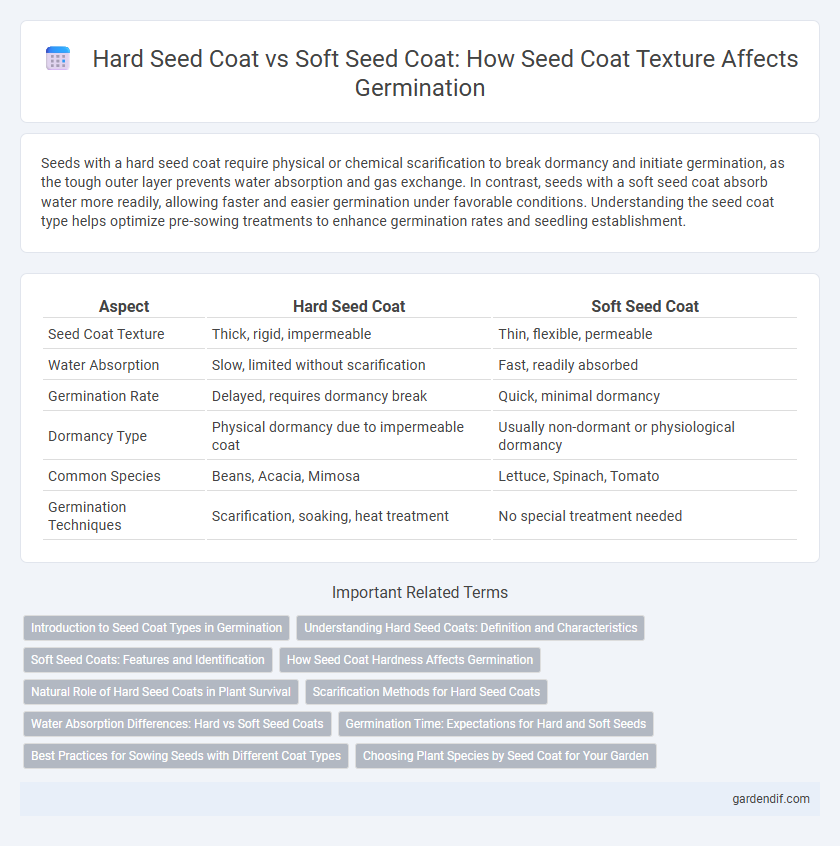
Hard Seed Coat vs Soft Seed Coat Illustration
Seeds with a hard seed coat require physical or chemical scarification to break dormancy and initiate germination, as the tough outer layer prevents water absorption and gas exchange. In contrast, seeds with a soft seed coat absorb water more readily, allowing faster and easier germination under favorable conditions. Understanding the seed coat type helps optimize pre-sowing treatments to enhance germination rates and seedling establishment.
Table of Comparison
| Aspect | Hard Seed Coat | Soft Seed Coat |
|---|---|---|
| Seed Coat Texture | Thick, rigid, impermeable | Thin, flexible, permeable |
| Water Absorption | Slow, limited without scarification | Fast, readily absorbed |
| Germination Rate | Delayed, requires dormancy break | Quick, minimal dormancy |
| Dormancy Type | Physical dormancy due to impermeable coat | Usually non-dormant or physiological dormancy |
| Common Species | Beans, Acacia, Mimosa | Lettuce, Spinach, Tomato |
| Germination Techniques | Scarification, soaking, heat treatment | No special treatment needed |
Introduction to Seed Coat Types in Germination
Hard seed coats provide a protective barrier that delays water absorption, requiring scarification or environmental triggers like temperature changes to initiate germination. Soft seed coats allow quicker water permeability, enabling faster seed swelling and embryo activation under favorable conditions. Understanding these seed coat types is crucial for optimizing germination strategies in agriculture and horticulture.
Understanding Hard Seed Coats: Definition and Characteristics
Hard seed coats are dense, impermeable layers that protect seeds from physical damage and microbial invasion, often composed of multiple tightly packed cell layers with lignin or suberin. These coats delay germination by preventing water absorption and gas exchange, requiring specific environmental cues such as scarification or temperature fluctuations to break dormancy. Understanding the structural integrity and chemical composition of hard seed coats is essential for optimizing germination techniques in agriculture and horticulture.
Soft Seed Coats: Features and Identification
Soft seed coats are characterized by their thin, permeable outer layers that facilitate water absorption and gas exchange essential for germination. These seed coats often appear smooth and pliable, lacking the tough, rigid structure found in hard seed coats, which makes them more susceptible to environmental factors like moisture and microbial attack. Identification of soft seed coats can be done by their translucency and ease of scarification, which contrasts with the impermeable nature of hard seed coats that delay germination.
How Seed Coat Hardness Affects Germination
Hard seed coats create a physical barrier that delays water absorption and gas exchange, significantly slowing the germination process. Soft seed coats allow quicker imbibition of water and oxygen penetration, facilitating faster and more uniform seed germination. The mechanical resistance of hard seed coats often requires scarification or environmental factors like temperature fluctuations to initiate germination.
Natural Role of Hard Seed Coats in Plant Survival
Hard seed coats play a crucial natural role in plant survival by providing physical protection against mechanical damage, pathogens, and desiccation, ensuring seeds remain viable under harsh environmental conditions. This tough outer layer delays germination until favorable conditions arise, often requiring environmental triggers such as temperature fluctuations or scarification to break dormancy. In contrast, seeds with soft seed coats tend to germinate quickly, making them more vulnerable to adverse factors but enabling rapid colonization in stable environments.
Scarification Methods for Hard Seed Coats
Hard seed coats require scarification methods to break physical dormancy and enhance water absorption essential for germination. Mechanical scarification, such as filing or nicking the seed coat, and chemical scarification using sulfuric acid treatments are effective techniques to weaken the tough outer layer. Thermal scarification by exposing seeds to hot water or heat also facilitates germination by disrupting impermeable seed coats in species like Acacia and Prosopis.
Water Absorption Differences: Hard vs Soft Seed Coats
Hard seed coats significantly restrict water absorption due to their dense, impermeable layers, delaying germination until environmental conditions soften or crack the coat. Soft seed coats absorb water rapidly, allowing quicker imbibition and faster initiation of the germination process. The difference in water permeability directly impacts seed dormancy duration and germination timing in various plant species.
Germination Time: Expectations for Hard and Soft Seeds
Hard seed coats significantly delay germination time due to their impermeability to water and gases, often requiring scarification or prolonged soaking to trigger the process. Soft seed coats allow rapid water absorption, resulting in faster germination typically within days to weeks under suitable conditions. Understanding these differences aids in optimizing seed treatment methods and predicting germination timelines accurately.
Best Practices for Sowing Seeds with Different Coat Types
Hard seed coats require scarification methods such as soaking, nicking, or abrasion to enhance water absorption and promote germination, ensuring the embryo receives adequate moisture. Soft seed coats generally need minimal pre-treatment but benefit from consistent moisture and proper soil temperature to prevent decay and encourage uniform sprouting. Selecting the appropriate sowing depth according to seed coat hardness prevents seed desiccation or excessive moisture retention, optimizing germination rates for both types.
Choosing Plant Species by Seed Coat for Your Garden
Selecting plant species with the appropriate seed coat type is crucial for successful germination in your garden. Hard seed coats require scarification or soaking to break dormancy and promote water absorption, making species like legumes ideal for gardeners willing to invest extra preparation time. Soft seed coat species, such as lettuce and radish, germinate quickly under standard conditions, offering faster growth for gardeners seeking immediate results.
Hard Seed Coat vs Soft Seed Coat Infographic

 gardendif.com
gardendif.com